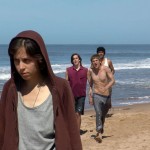Lucia Puenzo’s XXY, in case you haven’t heard, is a coming-of-age story about a hermaphrodite. Alex has lived the first fifteen years of her life as a girl, but the inevitable onset of sexual desire — bewildering enough to those of us not suffering from gender confusion — has done a number on her and also on her parents, who have gone out of their way to protect Alex from discrimination and from the well-intentioned curiosity of doctors. Rather than castrate Alex as an infant, they decided to allow her to choose her gender when she was ready. XXY examines the consequences of that decision. What I most liked about the film was its treatment of that post-pubescent madness we all suffered through. Another important character, a young boy struggling with some sexual confusion of his own, is as awkward, gangly, and desperate for affection as Alex is. I actually wish Alex had been a “normal” girl or boy because the enormity of her “situation” dominated every scene, allowing little breathing room for the characters to transcend the roles as written. I believe it was the Variety reviewer who described XXY as a very good after school special. A bit harsh maybe, but not far from my own take.
Secret Sunshine. I hate to write capsule reviews of films like this — sprawling, complex stories that pull off the remarkable feat of being simultaneously tragic, charming, inscrutable, and sublime. The tone of this thing could have collapsed at any moment; Lee Chang-dong is some kind of genius for pulling it off. Secret Sunshine is about a young woman, Shin-ae, who moves with her son to the small town where her now-deceased husband was born and raised. There she meets several locals, including a persistent suitor (Song Kang-ho in my favorite performance of the year), a pack of gossipy housewives, and a pharmacist who is convinced that Shin-ae would find true happiness if only she would turn her life over to Christ. After several plot turns that I refuse to spoil, Secret Sunshine becomes, among many other things, the truest depiction of evangelical Christianity I’ve seen on film. Fortunately, Lee’s film is not evangelical itself and, instead, wrestles with the strangeness and disappointments of faith in a way that The Mourning Forest, with its contrivances, could only mimic. Damn, I love this film.
And speaking of wrestling with faith (which, by the way, is far and away the dominant recurring theme of this year’s festival, or at least of my programmed version of it). I’ve gotten in the habit of describing Saverio Costanzo’s In Memory of Myself as a genre film, a suspense thriller in which the central, driving mystery is faith. It might be strangest film I’ve seen all week, with shades of Kubrick and Dreyer and a formal rigor I wasn’t expecting and have yet to fully process. I honestly don’t know if it’s a good film but I enjoyed every minute of it. I’m reserving all judgment until after a second viewing, which I hope comes sooner rather than later.
Hannes Schupbach’s Erzahlung is a commissioned portrait of Cesare Ferronato, an 80-year-old Italian sculptor. I’m a total sucker for films that document the artistic process, especially when they allow us to observe hands in action, but what most charmed me about this 40-minute, silent picture was its focus on Ferronato’s domestic life. There’s a wonderful moment, for example, when we watch him and his wife (I assume) play a game of chess. For Shupbach, there’s no distinction to be drawn between art-making and love and work and community — each is absolutely integral to the other.
Seeing Heinz Emigholz’s Schindler’s Houses on the massive screen in Varsity 1 was a real treat, but I really wish it had been programmed at any time other than 10 pm on Sunday night. I stayed strong for the first 75 minutes, but the last 25 are a bit of a blur. Fifteen challenging films in three days did me in. Schindler’s Houses is assembled from static shots of the homes and buildings Rudolf Schindler designed in and around Los Angeles between 1921 and 1952. They’re arranged chronologically and include both exterior and, in many cases, interior shots. The sheer quantity of footage has an interesting effect: Rather than the dusty curiosities you might find in a coffee-table collection of architectural photographs, the buildings shift and morph as they find new contexts. They’re domestic spaces that continually evolve to satisfy the tastes of their occupants. They’re material objects with material values (it’s impossible to watch the film and not be reminded of California’s real estate bubble). They’re objets d’art, relics of Modernism. Emigholz matches Schindler’s eye for composition; like Erzahlung this is another meeting of artists. As an aside, I would love to see a remix of this film using only shots of bookshelves (apparently a hallmark of Schindler’s designs). I have a fixation with browsing others’ bookshelves and found myself wanting to linger just a bit longer in front of those we see in the film.
